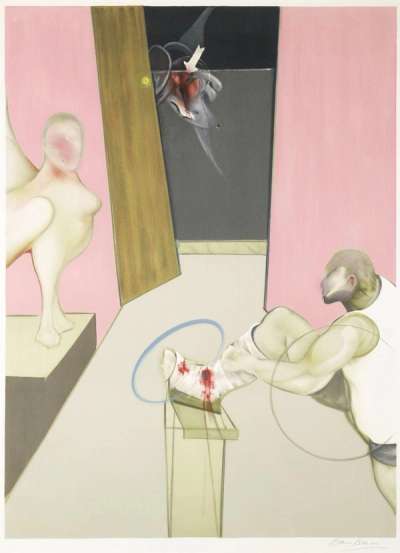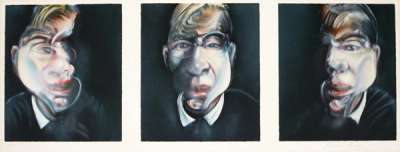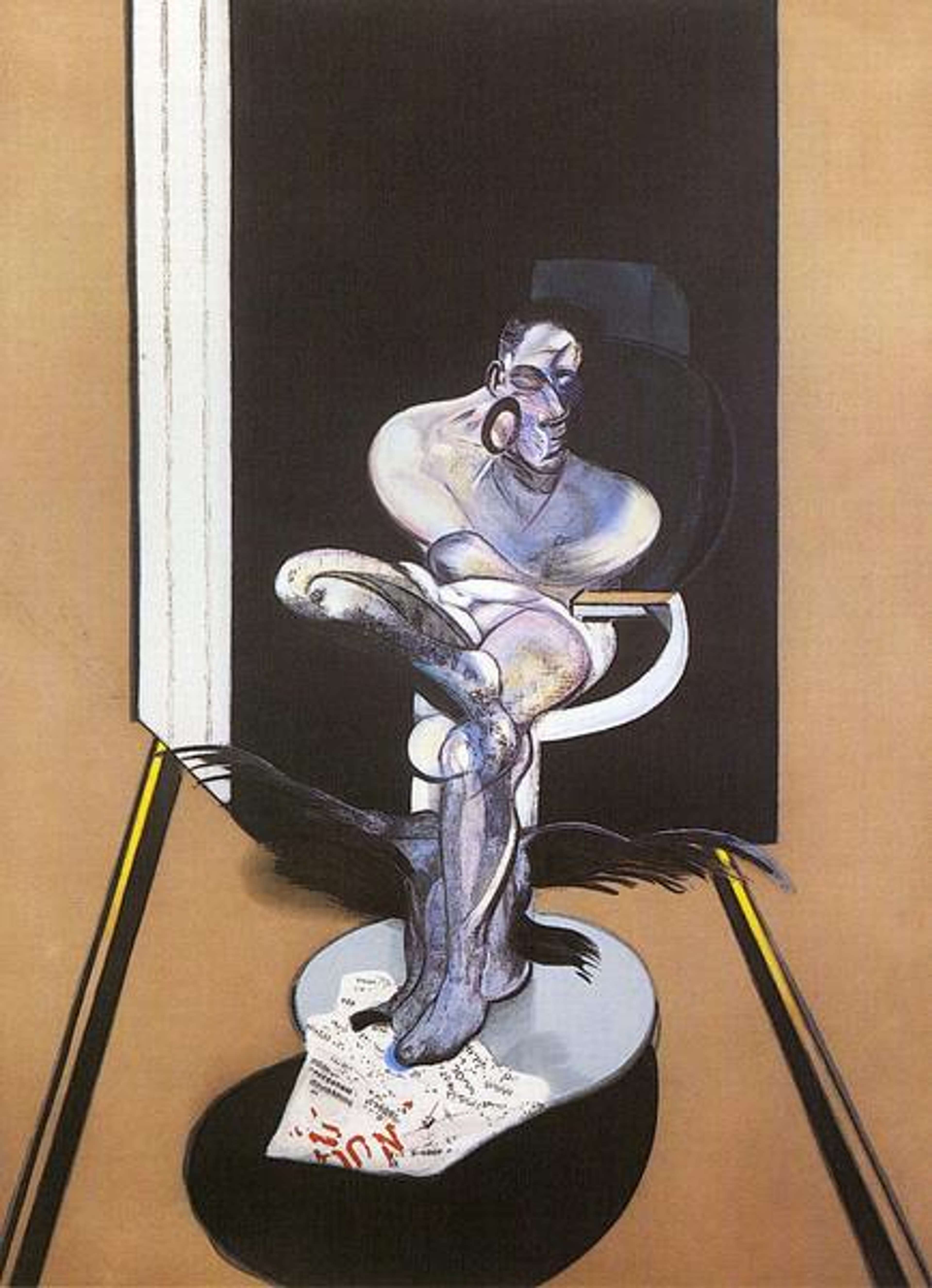Francis Bacon: Human Presence at the National Portrait Gallery

 Image © Contemporary2.0 / Francis Bacon 1909-1992 © 2022
Image © Contemporary2.0 / Francis Bacon 1909-1992 © 2022
Francis Bacon
58 works
Key Takeaways
Francis Bacon: Human Presence captures the tension between beauty and brutality, immersing viewers in an unflinching exploration of humanity. The exhibition presents an intimate yet inclusive narrative of Bacon’s artistic evolution. By incorporating archival materials and nods to Bacon’s influences, the exhibition contextualises his work while emphasising his distinctive modernity.
The Francis Bacon: Human Presence exhibition at the National Portrait Gallery is a striking immersion into the oeuvre of an artist who pursued beauty through a lens of anguish. Enticing, provocative, and emotionally visceral, it presents Bacon's work with a clarity and intensity that solidifies his place as one of the most audacious artists of the 20th century. Having only previously encountered Bacon’s work through digital or printed reproductions, witnessing Bacon’s art in person was breathtaking. The tactile portraits emerge as almost corporeal entities, dragging you into Bacon’s darkly intoxicating world.
A Tactile Encounter with Grief and Beauty
Walking through the Human Presence exhibition, the impact of Bacon’s paintings is immediate. The early rooms confront viewers with skeletal figures and haunting faces, locked within shadowy voids or compressed into claustrophobic frames. These works, particularly Study For A Portrait (1952) and Portrait of R. J. Sainsbury (1955), set the tone for the exhibition’s unflinching engagement with mortality and the fragile impermanence of existence. The figures seem to simultaneously emerge from and dissolve into their shadows, their screaming mouths, hollow eyes, and disintegrating forms evoking a haunting reminder of human vulnerability.
A startling motif in these early works is the prominence of teeth as symbols of decay and permanence. Teeth, the only part of our bodies that endures after death, encapsulate Bacon’s preoccupation with the paradox of existence; the persistence of the physical against the inevitability of its frailty. These are not merely portraits; they are profound meditations on the grotesque beauty and fragility of life. Encountering these works in person reveals dimensions that photographs simply cannot capture. The textures of Bacon’s paint - the brutal smears and carnal quality of his brushstrokes - add a tactile immediacy that heightens their emotional resonance. Up close, the canvases invite an intimate confrontation with themes of turmoil, identity, and the inexorable passage of time.
Intimacy and Alienation
The focus of the exhibition is Bacon’s fascination with the human form - not merely as a subject of beauty but as a vessel for pain, passion, and decay. This duality is epitomised in works like Head (Man In Blue) (1961) and Sketch for a Portrait of Lisa (1955), where figures seem to oscillate between defiance and dissolution. The large-scale portraits, such as Study for Self-Portrait (1963), exacerbate their impact, their imposing size amplifying their theatricality and existential gravitas.
The loose thematic arc of the exhibition crescendos in the final rooms, which focus on Bacon’s most intimate relationships. His paintings often depict his closest companions - lovers, friends, and fellow artists - not through the lens of comfort or flattery, but with unvarnished honesty. The section devoted to Henrietta Moraes is particularly striking - Bacon’s Three Studies for a Portrait of Henrietta Moraes captures her sensuality and vitality through swirling reds and fleshy tones, yet there is an undeniable vulnerability in her depiction. The exaggerated forms and chaotic brushstrokes articulate both the ecstasy and anguish of existence, underscoring Bacon’s ability to find unfiltered humanity in his subjects.
Equally affecting are the depictions of George Dyer, Bacon’s lover, whose presence - although muted in this exhibition - takes focus in the final room of the exhibition. From the sensual intensity of Three Studies for a Portrait of George Dyer (1964) to the harrowing eulogy of Triptych May-June 1973 (1973), which confronts the tragedy of Dyer’s overdose, these works delve into the brutal complexities of grief. Bacon’s art does not offer a sanitised portrayal of mourning; instead, it immerses viewers in its unrelenting presence, compelling them to confront the intricate interplay of love, loss, and despair.
What elevates this exhibition further is its nuanced contextualisation of Bacon’s life and relationships. Although Dyer’s presence feels notably absent for the majority of the works displayed, and his impact on Bacon’s art is somewhat downplayed in relation to the emphasis on Peter Lacy, the exhibition still offers a thoughtful rumination on the key players in Bacon's life. While the inclusion of archival materials and photographic portraits enriches the viewer’s understanding of his world, it never reduces the works to mere extensions of biography. Instead, this thoughtful curation enhances the intimacy of the paintings, allowing Bacon’s vision to resonate with unmitigated force.
A Theatre of Dark Inspiration
The large-scale portraits in Francis Bacon: Human Presence exert a commanding physical and emotional gravity, demanding both attention and introspection. Works such as Seated Figure (1961) and Portrait of George Dyer in a Mirror (1968) dominate the space, their monumental scale amplifying the emotional and existential weight they carry. These paintings are not just representations but performances, theatrical spaces where the drama of the human condition plays out.
Bacon’s deliberate use of frames and cage-like structures within his compositions intensifies this sense of theatricality. Figures often appear confined, suspended in existential limbo, their isolation underscoring the tension between presence and absence. This is also striking in Bacon’s smaller head triptychs, where fragmented renderings of the same subject suggest shifting identities and inner turmoil. These works capture the multiplicity of the human experience, reflecting Bacon’s belief that we are all works in progress, constantly negotiating the tensions between our best and worst selves. Through these visual devices, Bacon reflects his belief that although identity is not static, we often become trapped by our inner conflicts.
The Weight of Influence
Human Presence strikes a good balance in scope, offering enough of Bacon’s work to feel comprehensive without overwhelming the viewer. Its thematic arrangement highlights the evolution of Bacon’s artistic vision while underscoring the timelessness of his central preoccupations: mortality, fragility, and the human condition. Moreover, the decision to frame the works under glass - a practice Bacon insisted upon- contributes an evocative layer to the experience. The viewer’s reflection merges with the paintings, creating a poignant interplay between the self and the subject.
One of the exhibition’s strengths lies in its acknowledgment of Bacon’s artistic influences. The inclusion of Rembrandt’s Self-Portrait with Beret and Turned-Up Collar (1659) and the gallery dedicated to Van Gogh revealed the complexities behind Bacon’s genius. These additions do more than pay homage; they illuminate the influence of the Old Masters on Bacon whilst celebrating his ability to transform their legacy into something distinctly modern. Bacon’s fascination with Van Gogh is particularly evident in his Homage to Van Gogh (1960), where he reinterprets the Dutch master’s Self-Portrait with Bandaged Ear and Pipe (1889), amplifying the psychological turmoil through deep colours and a distorted visage.
The exhibition also includes Bacon’s relationship with photography and film, revealing how these mediums informed his approach to portraiture, and were often the artist’s preferred reference material. Although Bacon did sometimes have his subjects sit for him, he thought being in the same room as them inhibited him. Something that stood out was Bacon’s admission: “If I like them, I don’t want to practise the injury that I do to them in my work before them. I would rather practise the injury in private by which I think I can record the facts of them more clearly” - a statement that reveals Bacon’s complicity in the barbarity of his portraits. Photographic portraits of Bacon himself, as well as archival footage, further provide insight into his penchant for photography and being on film. These materials reveal an artist deeply attuned to the interplay between the ephemeral and the eternal - a theme that runs throughout his work.
 Image © Flickr / Figure with Two Owls, Study for Velazquez © Francis Bacon 1963
Image © Flickr / Figure with Two Owls, Study for Velazquez © Francis Bacon 1963A Legacy of Beauty and Brutality
Francis Bacon: Human Presence is a journey through grief, beauty, and existence. It transcends the boundaries of portraiture, offering a vision of humanity that is at once grotesque and sublime. To stand before these works is to see beauty in violence and grief, and portraits of unvarnished complexity. For those who enter Bacon’s world, the experience is unforgettable - a haunting and exhilarating encounter with an artist who found meaning in the contradictions of being.


























